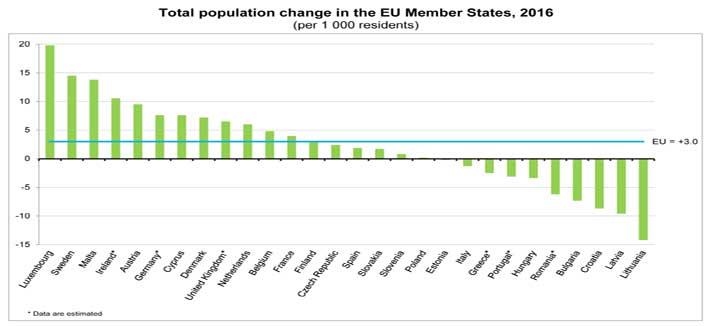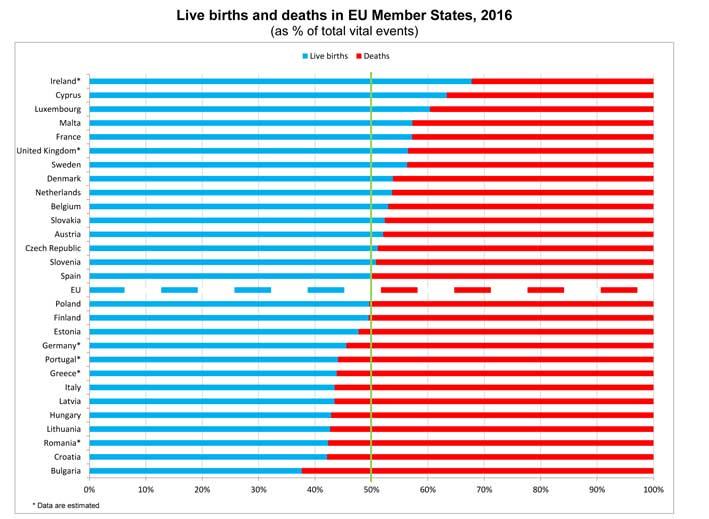Malta with the third highest population increase in the EU
Despite being the smallest country in the EU, Malta has registered the third highest population increase in the EU in 2016.
This was revealed by Eurostat in a release issued earlier this week.
On 1 January 2017, the population of the European Union was estimated at 511.8 million, compared with 510.3 million on 1 January 2016.
During the year 2016, as many births as deaths were recorded in the EU (5.1 million), meaning that the natural change of the EU population was neutral. The population change (positive, with 1.5 million more inhabitants) was therefore due to net migration.

With 82.8 million residents (or 16.2% of the total EU population at 1 January 2017), Germany is the most populated EU Member State, ahead of France (67.0 million, or 13.1%), the United Kingdom (65.8 million, or 12.9%), Italy (60.6 million, or 11.8%), Spain (46.5 million, or 9.1%) and Poland (38.0 million, or 7.4%).
For the remaining Member States, nine have a share of between 4% and 1.5% of the EU population and thirteen a share below 1.5%.
These figures are issued by Eurostat, the statistical office of the European Union, just before the World Population Day (11 July).
During 2016, the population increased in eighteen EU Member States and decreased in ten.
The largest relative increase was observed in Luxembourg (+19.8 per 1 000 residents), ahead of Sweden (+14.5‰), Malta (+13.8‰), Ireland (+10.6‰), Austria (+9.5‰), Germany and Cyprus (both +7.6‰), Denmark (+7.2‰), the United Kingdom (+6.5‰) and the Netherlands (+6.0‰),
In contrast, the largest decrease was recorded in Lithuania (-14.2‰), followed by Latvia (-9.6‰), Croatia (-8.7‰), Bulgaria (-7.3‰) and Romania (-6.2‰).
In total, the population of the EU increased by 1.5 million people (+3.0‰) during the year 2016.
Malta's population was recorded as having increased by no less than 13.8% in 2016 bringing the total Malta population to 440,400.

During the year 2016, 5.1 million babies were born in the EU, 11 000 more than the previous year. Across Member States, the highest crude birth rates in 2016 were recorded in Ireland (13.5 per 1 000 residents), Sweden and the United Kingdom (both 11.8‰) and France (11.7‰), while the lowest were registered in Southern Member States: Italy (7.8‰), Portugal (8.4‰), Greece (8.6‰), Spain (8.7‰), Croatia (9.0‰) and Bulgaria (9.1‰). At EU level, the crude birth rate was 10.0 per 1 000 residents.
In the meantime, 5.1 million deaths were registered in the EU in 2016, almost 91 000 fewer than the previous year. Ireland and Cyprus (both 6.4 per 1 000 residents) as well as Luxembourg (6.8‰) had in 2016 the lowest crude death rate, followed by Malta (7.6‰), the Netherlands (8.7‰), Spain and France (both 8.8‰). At the opposite end of the scale, Bulgaria (15.1‰), Latvia (14.6‰), Lithuania (14.3‰), Romania and Hungary (both 13.0‰) recorded the highest. The crude death rate was 10.0 per 1 000 residents in the EU.
Consequently, Ireland (with a natural change of its population of +7.1‰) remained in 2016 the Member State where births most outnumbered deaths, ahead of Cyprus (+4.7‰), Luxembourg (+3.6‰), France (+3.0‰), Sweden and the United Kingdom (both +2.7‰) and Malta (+2.6‰).
In contrast, among the thirteen EU Member States which registered a negative natural change in 2016, deaths outnumbered births the most in Bulgaria
(-6.0‰), followed by Lithuania (-3.7‰), Romania (-3.5‰), Croatia and Latvia (both -3.4‰) and Hungary (-3.2‰).